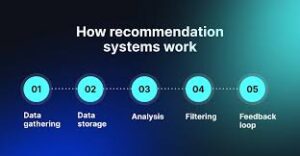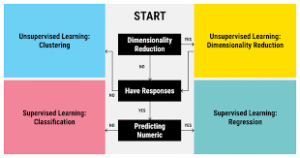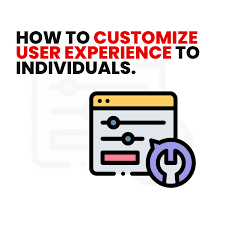
Recommendation Engine Development is no longer a luxury in today’s competitive digital world—it is the very essence of doing business. Whether it’s the movies on Netflix or the product suggestions on Amazon, recommendation engines have redefined how customers experience platforms and interact with brands.
Here is a hint- if you do not want your business to fail to enhance engagement and improve sales and customer retention, your next step should be purchasing a highly efficient recommendation engine. No matter what business you are into, e-commerce business, streaming service, or online education, these seven potent courses of actions will guide you towards developing the recommendation engine that will achieve the best performance.
1. Specify the Objectives of Your Recommendation Engine Development
You will need to establish what you will code or select the algorithms before doing any actual coding. Are you promoting products/articles/videos, or services? Want to raise click through rates, sales, or retention of users?
The focus on your objectives will define:
The type of recommendation algorithm you use.
The data collection strategy you adopt.
The metrics you track for success.
As an example, Netflix maximizes watch time whereas Spotify maximizes music discovery and satisfaction.
Insider Tip: Companies may visit Workvix.com to find out what AI-backed development solutions a company can use to align technology ambitions with concrete outcomes.
2. Obtain Quality, Relevant Data for Successful Recommendation Engine Development
The quality of your data that you provide to your recommendation engine is just as good. Bad, partial, or irrelevant information will result in poor recommendations, which will deteriorate the user confidence.
The kinds of data you may collect are:
Explicit feedback (ratings, likes, reviews).
Implicit feedback (clicks, purchase history, browsing behavior).
Geographical information (where, what device, what time).
Forbes states that up to 15 percent of additional revenue may be achieved through personalization, which is only possible in case there is a good structuring of information, relevance, and accuracy.
3. Select proper Algorithm

Recommendation engines have many algorithms and whatever algorithm you settle with will depend on your business model:
Collaborative Filtering- These filter or recommend on the basis of similarities, of user (used by Amazon).
Content-Based Filtering- Recommends things that are like the ones the user has touched on (in use by IMDB).
Hybrid Systems – Use both techniques in order to have a higher accuracy (Applied by Netflix).
Wisdom of the Expert: The advantage of using Workvix.com platforms is that they are expertly customized to the specific application of your needs with integration of custom algorithms.
4. Speed & Scalability Optimized
An engine such as a recommendation engine must provide quick suggestions in real time, particularly on large platforms. In recommendation engine development, speed is a critical factor—users get frustrated with slow recommendations, which can lead to cart abandonment or reduced engagement.
The most important optimization:
Fast access using in-memory databases such as Radis.
Use batch processing on the high data.
Leverage the cloud to grow leanly.
Google Cloud estimates that cloud or recommendation systems are capable of supporting millions of requests per second with very low latencies.
5. Customize User Experience

In this competitive market, generic recommendations will fail to accommodate the current scenario. The recommendations should feel like they are selected specifically to the end-user.
Personalization strategies:
Use behavioral information in algorithms.
Revise advice in accord with seasonal patterns.
Offer active filtering of the users that can narrow down results.
Another example: Let us say that e-commerce site suggests winter jackets in colder times, although a user had never searched winter jackets in the past.
To learn how the AI software can adjust your recommendations on a per real time basis, please visit Workvix.com to learn more about advanced personalization techniques.
6. Test and Test with Improvements
A recommendation engine is never in a state of completion—it must be continually adjusted. In recommendation engine development, this adaptability is crucial because consumer behaviors change, market trends evolve, and algorithms must be refined to keep delivering accurate, relevant suggestions.
Effective ways of testing:
Testing versions of the recommendation models using the A/B testing method.
Monitoring major key performance indicators (CTR, conversion rates, retention rates).
Evaluation of feedback loops with the object of enhancing accuracy.
Case Study: Harvard Business Review share the statistics of companies that implemented and continuously making updates in their models that increased the accuracy of recommendations by 30%.
7. Hold Ethics and Data Privacy in the first place
Nowadays consumers are more aware of data privacy than they have ever been. Establishing a trust relationship implies guarding the creation of personal effects without surrendering the user data.
Best practices:
Be open with policies of data collection.
Offer the possibility to turn off data tracking.
Follow GDPR and CCPA.
The recommendation engine presented properly should increase user confidence and not decrease that trust. Systems such as Workvix.com will assist you to have a powerful yet compliant platform.
Final Thoughts
High-performance recommendation engine can change the way users are engaged, created sales and enhanced brand loyalty, it is just that it has to be built with the correct strategies at the lower levels.
Here are seven strong steps, including formulating goals, pooling quality data, determining the right algorithm, and being ethical: Take them and you will build a recommendation system that will not only recommend, but make your users happy, as highlighted by TechCrunch’s AI innovation insights.
To have a recommendation engine that is empowered by AI start today with professional assistance of Workvix.com and beat your competitors.

